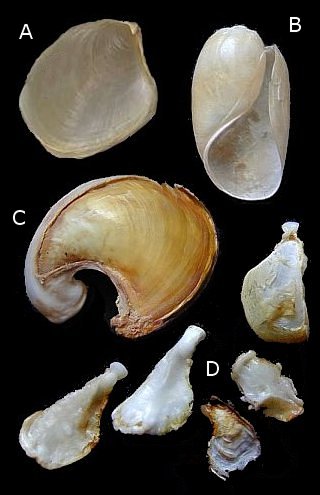
The shell in Sea Hares
Order: ANASPIDEA
PHOTO
A, Aplysia juliana (shell width - 25mm). B, Akera soluta (shell height - 19mm). C, Dolabella auricularia (longest dimension - 67 mm). D, Dolabrifera brazieri 5 shells, to show variability, (longest shell - 15mm). E, Aplysia sp. with parapodia flaps open to show mantle flap covering shell (arrow). F, Akera soluta with inset showing shell.
Photos: B,C,D, Alison Miller. A,E,F, Bill Rudman.
Like most orders of opisthobranch sea slugs, the story of Sea Hare (Order Anaspidea) evolution concerns the gradual loss of the shell.
Akera (B,F) has the most primitive features and retains a relatively large external shell, similar to that found in some sacoglossans and cephalaspidean bubble shells such as Atys.
In species of Aplysia (E) and Syphonota the shell is a flattened lightly calcified plate, which is partially or fully enclosed in the mantle skin (arrow) and forms a weak protective layer over the viscera and the gill. It is clearly now a remnant organ with Sea Hare defence now mainly achieved by colour camouflage and various glandular secretions.
In Dolabella auricularia (C), the ear-shaped shell which gives it its name, is heavily calcified and lies enclosed in the circular shield at the back of the body. Although heavily calcified it is clearly another example of the gradual loss of the shell. Another example is found in Dolabrifera (D), in which the shell is a small, often irregularly shaped plate.
In other genera, such as Stylocheilus and Bursatella, the shell is completely absent.
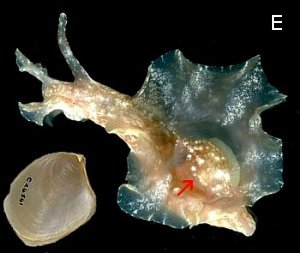
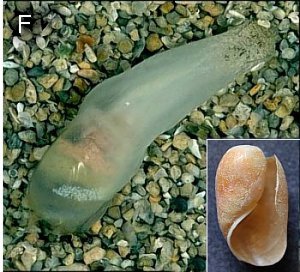
Rudman, W.B., 2000 (August 27) The shell in Sea Hares. [In] Sea Slug Forum. Australian Museum, Sydney. Available from http://www.seaslugforum.net/find/aplyshell
Related messages
Aplysia shell from Majuro
November 29, 2007
From: David Kirsh
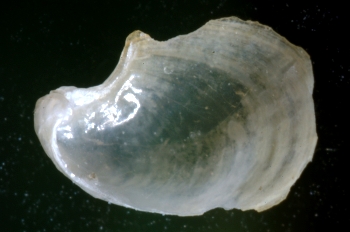
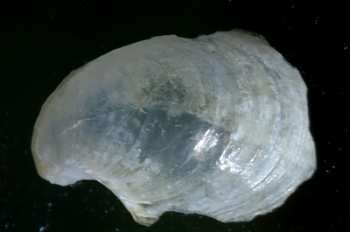
I'm wondering if someone can identify this shell from 69 feet on the reef wall outside the boat channel of Majuro in the Marshall Islands.
It's 3.5 mm in length.
Locality: Majuro, 69 feet , Marshall Islands, Pacific, May 2005, reef wall. Length: 3.5mm. Photographer: David Kirsh.
David Kirsh
mediashun@mindspring.com
Kirsh, D., 2007 (Nov 29) Aplysia shell from Majuro. [Message in] Sea Slug Forum. Australian Museum, Sydney. Available from http://www.seaslugforum.net/find/21181Dear David,
The shell in sea hares [see Fact Sheet] is in the process of disappearing and so has becaome a fairly featureless structure. In the genus Aplysia, with few exceptions, it is very difficult to identify shells to the species level. At 3.5 mm in length I suspect your shell is from a juvenile, but to cpmpound thhe problem, juvenile shells are amost impossible to identify to species. The most likely small species your would find is Aplysia parvula and its shell is more elongate in shape and usually quite brown.
Best wishes,
Bill Rudman
Shell of Aplysia
August 30, 2000
From: Yoshiaki J. Hirano
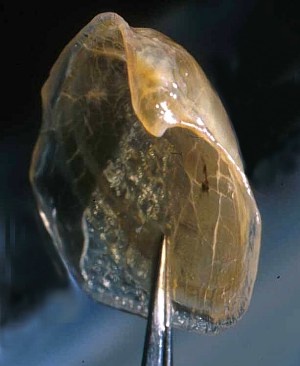
Dear Bill,
I was asked by a friend of mine about the shell of Aplysia spp. He is interested in whether the shell functions, for example, as a support structure for body shape or just a trace inherited from more primitive forms of opisthobranchs. My impression is the latter, so I took some examples apparently showing a trend of shell reduction from Akera through Aplysia to Notarchus species in Anaspidea. I would be happy if you or someone else kindly give us some idea concerning this question. I have attached a photo of the shell of Aplysia juliana.
Best wishes,
Yoshi
hiranoyj@earth2.s.chiba-u.ac.jp
Hirano. Y.J., 2000 (Aug 30) Shell of Aplysia. [Message in] Sea Slug Forum. Australian Museum, Sydney. Available from http://www.seaslugforum.net/find/2928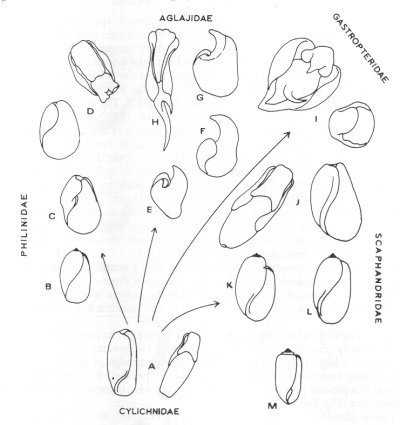
Dear Yoshi,
I agree that the shell of Aplysia is a remnant from ancestors with larger more calcified snail-like shells. I have prepared a new page showing some examples of this.
This gradual loss of shell is found recurring many times within the opisthobranchs. I have included alongside an example amongst the philinoideans from Cylinchna with a heavily calcified external shell giving rise to the aglajids and philinids in which the shell is flattened, fragile and internal, and the gastropterids, which if they have an internal shell, it is a fragile and uncalcified.
[FROM: Rudman, W.B. (1978)
A new species and genus of the Aglajidae and the evolution of the philinacean opisthobranch molluscs. Zoological Journal of the Linnean Society, 62: 89-107.]
Have a look at the pages on How snails became slugs and What is a slug?.
Best wishes,
Bill Rudman.
Shell reduction in the Sea Hares
August 30, 2000
From: Bill Rudman
To answer Yoshi's message about the loss of the shell in Sea Hares, I have prepared a new page on the topic. Over the next few days I will add some notes and more photos to illustrate some shells in more detail.
Best wishes,
Bill Rudman.
